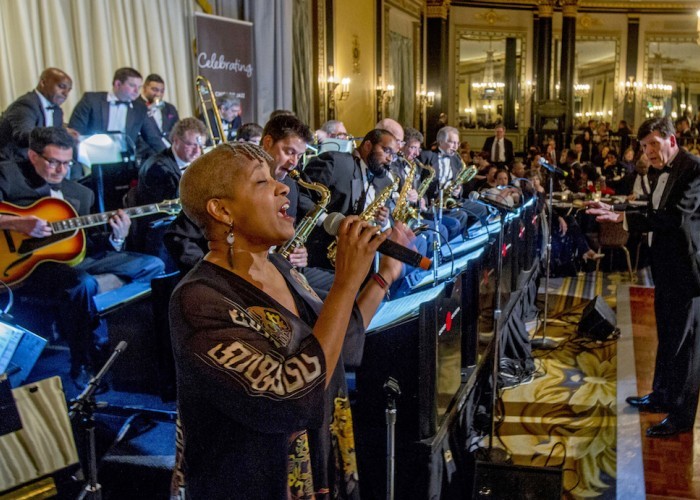Dec 9, 2025 12:28 PM
In Memoriam: Gordon Goodwin, 1954–2025
Gordon Goodwin, an award-winning saxophonist, pianist, bandleader, composer and arranger, died Dec. 8 in Los Angeles.…

René Marie (foreground) performs with the Chicago Jazz Orchestra, conducted by Jeff Lindberg, in Chicago on March 29.
(Photo: Charles Osgood)The Chicago Jazz Orchestra recently marked its 40th anniversary, and the ensemble commemorated the milestone with a March 29 concert that reaffirmed why it remains a vibrant, valued institution. Underneath elegant chandeliers at Chicago’s historic Palmer House hotel, the CJO and guest vocalist René Marie powered through Count Basie and Duke Ellington anthems, taking a side turn for the singer’s distinctive Eartha Kitt tribute. Throughout, the big band demonstrated that this was not music for quiet observation. The dance floor remained occupied all night.
The orchestra had much to celebrate. Generations of gifted musicians have honed their skills through the ensemble in large auditoriums and small clubs. The CJO also has navigated the financial challenges inherent in maintaining a large ensemble, making difficult moves onstage and off seem like effortless swing. Conductor and artistic director Jeff Lindberg has worked hard to keep the band’s repertoire diverse.
“Initially [in the late 1970s], it was kind of a novel thing, and the tenor of the day was, ‘Why do you want to do that old stuff? Do the newer stuff,’” Lindberg said. “My argument is that they’re not mutually exclusive—you can have innovative new music and you can play music of the masters. They’re not going to cancel each other out.”
Lindberg and trumpeter Steve Jensen confronted those perceptions when they moved to Chicago after they graduating from the University of Illinois at Urbana–Champaign. Originally named The Jazz Members Big Band, the group played for the door on Sundays at a North Side club called Gaspar’s.
“Sometimes the musicians got three dollars, sometimes we might get seven or eight, but that’s how we got going,” Lindberg said. “We struggled the first year. In fact, that rough winter [of 1979] almost closed everything down completely.”
Opportunities grew despite such obstacles. After playing the Chicago Jazz Festival in 1981, singer Joe Williams helped the ensemble land recurring concerts at the Kennedy Center in Washington, D.C. Two years after Jensen’s death in 1997, Lindberg changed the name to the CJO, because he wanted to diversify the repertoire and include strings and larger orchestrations. This expansion also included recording with such guests as the late trumpeter Clark Terry on 2004’s Porgy & Bess (Americana Music) and vocalist Cyrille Aimée on 2013’s Burstin’ Out! (Origin). Today, CJO receives funding from public and nonprofit supporters, including the Illinois Arts Council Agency and Richard H. Driehaus Foundation, according to executive director Travis Rosenthal.
CJO bassist Dennis Carroll added that the ensemble thrives essentially because of Lindberg’s dedication—even with his full-time job as a music professor at The College Of Wooster in Ohio.
“Jeff comes in from near Cleveland for every little gig,” Carroll said. “Even if it’s a door gig that isn’t close to paying his gas, Jeff always shows up. And when the gig’s over, he’s tearing it all down.”
Those regular club performances also distinguish the CJO from many other repertory orchestras. Over the decades, the band frequently has played clubs in Chicago and its suburbs, including Andy’s, the Green Mill and FitzGerald’s.
“We never lost our nightclub roots,” Lindberg said. “Some groups won’t play in clubs, because they want to keep the music in a respectful light. But one of the things about playing in a jazz club is it’s so spontaneous. Sometimes it’s looser, but still it swings and solos can be a bit more adventurous than if you’re playing in a 2,000-seat hall. We want to keep that spontaneity going.” DB

Goodwin was one of the most acclaimed, successful and influential jazz musicians of his generation.
Dec 9, 2025 12:28 PM
Gordon Goodwin, an award-winning saxophonist, pianist, bandleader, composer and arranger, died Dec. 8 in Los Angeles.…

Nov 13, 2025 10:00 AM
For results of DownBeat’s 90th Annual Readers Poll, complete with feature articles from our December 2025 issue,…

Flea has returned to his first instrument — the trumpet — and assembled a dream band of jazz musicians to record a new album.
Dec 2, 2025 2:01 AM
After a nearly five-decade career as one of his generation’s defining rock bassists, Flea has returned to his first…

“It’s a pleasure and an honor to interpret the music of Oscar Peterson in his native city,” said Jim Doxas in regard to celebrating the Canadian legend. “He traveled the world, but never forgot Montreal.”
Nov 18, 2025 12:16 PM
In the pantheon of jazz luminaries, few shine as brightly, or swing as hard, as Oscar Peterson. A century ago, a…

Dec 11, 2025 11:00 AM
DownBeat presents a complete list of the 4-, 4½- and 5-star albums from 2025 in one convenient package. It’s a great…